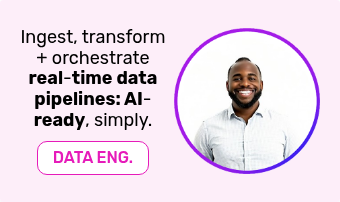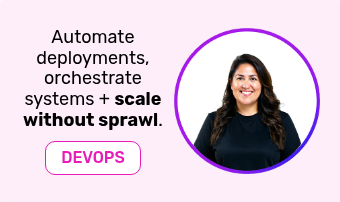The role of IT professionals is transforming.
Traditionally, IT teams and developers have concentrated on maintaining infrastructure and safeguarding security, ensuring the seamless operation of systems and addressing issues as they emerge. However, as technology advances, the responsibilities of those who oversee and construct these systems are also evolving.
Today, for many organisations, IT is now very much seen as an enabler, with roles increasingly focused on creating value, supporting rapid change, and being at the heart of delivering on wider business strategy - what they do needs to drive the bottom-line.
As roles evolve, a significant transformation is the shift towards real-time, unified (ever-expanding) technology ecosystems that seamlessly integrate data, automation, and AI to achieve tangible business outcomes. This shift is not just about connecting to the bottom line - though its importance is unavoidable - but also about harnessing new, advanced technologies in a business-orientated, focused way to help improve operational efficiency, minimise system fragmentation, and enable businesses to fully exploit their data's potential.
But why is this transformation occurring, how can they proceed effectively, and what does it mean for IT professionals in the next five years?
Why IT’s Role Is Changing.
Several factors are driving this shift:
- The Rise of Automation + AI: According to a 2023 McKinsey1 report, 50% of current work activities could be automated using today’s technology . This means IT teams are increasingly expected to integrate automation into business processes, reducing manual tasks, and increasing efficiency. With AI and machine learning now embedded into many business applications, developers must understand how to leverage these technologies for predictive maintenance, supply chain optimisation, and customer experience enhancement.
- Increased Demand for Custom Solutions: Businesses no longer want off-the-shelf products that don’t fit their needs. A 2022 report by Deloitte2 noted that 80% of companies believe their digital strategy needs to be customised to their industry and business needs. IT teams, therefore, need to develop and deploy bespoke solutions faster than ever before, requiring platforms that support rapid development through low-code and no-code environments.
- Data as a Central Asset: In today’s digital economy, data is one of a company’s most valuable resources. IT teams are responsible for ensuring that data is not only accessible but also actionable. This requires systems that provide real-time analytics and insights, helping the business to respond to opportunities and threats as they happen.
- Security + Compliance: As businesses expand their use of cloud services, IoT, and edge computing, security concerns grow. Gartner3 predicts that by 2025, 45% of organisations will have experienced attacks on their software supply chains . IT teams are increasingly tasked with securing data across diverse environments, from cloud to edge, making unified platforms that handle security across multiple layers more critical than ever.
The Importance of Real-Time, Unified Technology Ecosystems.
A unified technology ecosystem is one where all business systems, from legacy infrastructure to cutting-edge AI, work together seamlessly. This kind of integration is vital in a world where data is generated from an increasing number of sources including devices, cloud services, SaaS, data streams, and on-premise systems.
Platforms that can unify data ETL, analysis, and facilitate the real-time use of it across organisations (with workflow, automation, AI and complete custom app development capabilities) in a single environment are becoming indispensable for IT teams. The reason for this is that they solve integration challenges, allow for real-time decision-making, and enable businesses to scale quickly without replacing their entire technology stacks:
- Real-Time Data Utilisation: One of the biggest benefits of a unified platform is the ability to use data in real time. Whether it's monitoring equipment health, optimising energy use, or tracking customer behaviour, real-time analytics enable businesses to respond proactively rather than reactively. In industries such as manufacturing and logistics, where downtime can cost millions, the ability to predict and prevent failures is game-changing.
- Reduction of System Fragmentation + Closing of Data Silos: IT teams are often tasked with managing a mix of legacy systems, cloud applications, and newer technologies like IoT and AI. Managing these disparate systems can be a logistical nightmare, leading to numerous inefficiencies, errors and workarounds that easily founder with updates and additions. By integrating everything together via single platform, developers can focus on building value-driven applications, automated workflows, and delivering insights where they need to go in a timely manner, rather than constantly troubleshooting integration issues.
- Improved Collaboration + Efficiency: Unified platforms make collaboration between IT teams and other departments easier. Instead of having to manually pull data from various systems and cobble together reports, (bye bye spreadsheets), IT teams can automate these processes. This reduces time wasted on repetitive tasks and ensures that everyone in the organisation has access to the same up-to-date information.
- Security + Compliance: As more business-critical applications are deployed in cloud and edge environments, ensuring that data is secure across all layers of the stack becomes more difficult. A unified platform allows IT teams to manage security centrally, applying consistent policies and ensuring compliance with industry regulations across the entire ecosystem.
Where IT and Developers Will Be in Five Years.
The shift towards real-time, unified ecosystems will redefine the role of IT professionals over the next five years. As automation, AI, and real-time data analytics become more integrated into everyday business processes, IT teams will transition from system administrators to business enablers.
We predict 5 major changes:
- A Strategic Partner in Decision-Making: IT teams will move beyond their traditional support role to become key partners in decision-making. With real-time data at their fingertips, developers will play an essential role in building and maintaining systems that provide insights into all areas of the business, from operations to customer behaviour.
- Focus on High-Level Problem Solving: Automation and AI will take over many of the routine tasks that currently occupy IT teams, such as monitoring systems, troubleshooting, and managing integrations. Instead, developers will spend their time on higher-level problem solving, such as optimising workflows, developing new features, and driving innovation.
- Increased Emphasis on Data Security: As cyberattacks become more sophisticated, IT professionals will focus even more on securing the organisation’s data. Platforms that can manage security across cloud, edge, and on-prem environments will become increasingly important, allowing IT teams to focus on broader strategic initiatives.
- Expanding the Role of Developers: With the rise of low-code/no-code platforms, developers will spend less time writing code and more time building custom solutions that meet the business's needs. They will increasingly work in cross-functional teams, collaborating with business leaders, operations, and data scientists to develop and deploy highly-customised solutions quickly and efficiently.
- Targeted, Business-Focused Use of New Technologies (AI, anyone?): At the moment, everyone is talking a good game about AI, but IT professionals will increasingly need to focus on personalising AI and machine learning use to fit specific business needs in the real-world, regardless of skillsets. Harnessing Generative AI (GenAI) and Machine Learning will enable predictive analytics and automated decision-making tailored to individual business contexts, whether it’s predicting customer demand, optimising workflows, or reducing downtime. The ability to customise these technologies - based on unique data sets and operational nuances - will be critical for delivering actionable insights and driving more precise, impactful decisions across industries. Personalisation will become the differentiator in leveraging AI effectively, so new toolkits that enable them to do this will need to be leveraged.
The future of IT is moving towards unified, real-time technology ecosystems that break down silos, automate processes, and provide actionable insights across the organisation that deliver a measurable ROI.
As developers and IT teams adapt to this new paradigm, their role will become increasingly strategic, focused on driving innovation, ensuring security, and enabling real-time decision-making.
The next five years promise to be a transformative period for IT professionals, one in which they will play an even more central role in the success of their organisations and platforms like Rayven’s, (which bring together low-code app development, iPaaS, Data, AI, IoT, Workflow Automation, BI and PaaS capabilities into a single, All-in-One and easy-to-use toolkit) will be key to facilitating them to make this transition.
If you'd like some free advice on how we can help, do get in contact and book a free consultation with one of experts.
References:
- Automation and AI Impact: The McKinsey report stating that 50% of current work activities could be automated using today’s technology can be found in their 2023 report on the future of work. Source.
- Demand for Custom Solutions: The statistic from the 2022 Deloitte report that 80% of companies believe their digital strategy needs to be customised comes from their “Digital Transformation 2022” survey. Source.
- Security Concerns in IT: Gartner’s prediction that 45% of organisations will experience attacks on their software supply chains by 2025 is detailed in their security forecast. Source.




















































